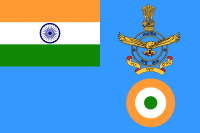Arjan Singh
Marshal of the Indian Air Force Arjan Singh Aulakh, DFC (15 April 1919 – 16 September 2017) was a senior air officer of the Indian Air Force. He served as the 3rd Chief of the Air Staff from 1964 to 1969, leading the Air Force through the Indo-Pakistani War of 1965. He was the first and only officer of the Indian Air Force (IAF) to be promoted to five-star rank as Marshal of the Indian Air Force, equal to the army rank of Field Marshal.
Arjan Singh Aulakh | |
|---|---|
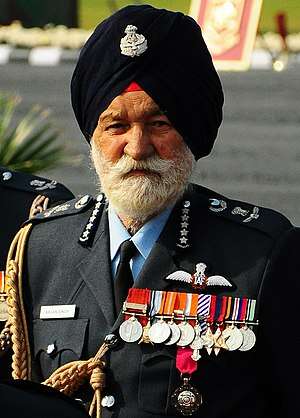 | |
| Born | 15 April 1919 Lyallpur, Punjab, British India (now Faisalabad, Pakistan) |
| Died | 16 September 2017 (aged 98) New Delhi, India |
| Allegiance | |
| Service/ | |
| Years of service | 1938–1969 2002–2017[lower-alpha 2] |
| Rank | |
| Commands held | Chief of the Air Staff Operational Command Ambala Air Force Station Air Force Station Kohat Air Force Station Risalpur No. 1 Squadron IAF |
| Battles/wars | World War II Indo-Pakistani War of 1947 Indo-Pakistani War of 1965 |
| Awards | |
Singh joined the Royal Air Force College Cranwell at the age of 19 and graduated in 1939. He joined the No. 1 Squadron IAF and served in the North-West Frontier Province. In World War II, he commanded this squadron during the Arakan Campaign and was awarded the Distinguished Flying Cross. In 1945, he attended the RAF Staff College, Bracknell. After the Partition of India in 1947, he led the first fly-past of Royal Indian Air Force (RIAF) aircraft over the Red Fort in Delhi. He then commanded Air Force Station, Ambala at the rank of Group Captain. In 1950, after completing the staff course at Joint Service Defence College, Latimer, Buckinghamshire, he was promoted to the rank of Air Commodore and took over the Operational Command. He commanded the Operational Command in two stints. In 1958, the post was upgraded to Air Officer Commanding-in-Chief at the rank of Air Vice Marshal.
After attending the Imperial Defence College in 1960, he served as the Air Officer in charge of Administration at Air Headquarters. In 1963, he took over as the Deputy Chief of the Air Staff and then as the Vice Chief of the Air Staff. Singh assumed office as the Chief of the Air Staff, on 1 August 1964. For his distinguished service in commanding the IAF during the Indo-Pakistani War of 1965, he was awarded the Padma Vibhushan and in 1966 became the first IAF officer to be promoted to Air Chief Marshal.
After retiring from the IAF, Singh served as a diplomat, politician and advisor to the Government of India. He served as India's Ambassador to Switzerland, the Holy See and Liechtenstein from 1971 to 1974 and as the High Commissioner of India to Kenya from 1974 to 1977. He then served as the Lieutenant Governor of Delhi from 1989 to 1990. In January 2002, the rank of Marshal of the Indian Air Force was conferred on Singh, the first and only officer of the IAF to receive the honour.
Early life and education



Singh was born on 15 April 1919 in Lyallpur (now Faisalabad),[1] a town in the erstwhile Punjab Province of British India (in present-day Pakistan), into an Aulakh Jat family.[2] Men from the family had joined the armed forces, in keeping with community traditions, and Singh was the fourth generation of his family to join the British Indian armed forces.[3]
Singh's father was a Lance Daffadar in the Hodson's Horse at the time of his birth, and retired as a full Risaldar in the Cavalry, serving for a time as ADC to a Division Commander.[4] His grandfather Risaldar Major Hukam Singh served in the Guides Cavalry between 1883 and 1917,[4] and great-grandfather, Naib Risaldar Sultana Singh, was among the first two generations of the Guides Cavalry enlisted in 1854; he was martyred during the Afghan campaign of 1879.[3] Thus, after three generations of men serving in the lower and middle ranks of the army, Singh was to become the first member of his family to become a commissioned officer.[5]
Singh was educated at Montgomery, British India (now Sahiwal, Pakistan) and was a well-known sportsman. Singh then attended the Government College Lahore. He was the Captain of the College swimming team and set four Punjab and four University records in swimming. He also won the All-India One-mile swimming event in 1938.[6] Singh entered the RAF College Cranwell in 1938. At the College, he was the Vice Captain of the swimming, athletic and hockey teams.[7]
Military career
World War II
Singh was commissioned as a Pilot Officer in December 1939, after topping the Empire Pilot training course among his batch of Indian Cadets. He joined No. 1 Squadron which was then stationed at Air Force Station Kohat in the North-West Frontier Province (NWFP) and flew Westland Wapiti biplanes. The Squadron was conducting operations against the tribal forces in NWFP, in which he participated. While flying with the squadron in NWFP, Singh's Hawker Audax was shot down by the Pathans. He crashed in a dry stream in the midst of a fight between British troops and the Pathans. He was not hurt and within two weeks he was flying again in the same area. According to Singh, fighting in the NWFP prepared the squadron for the fight against the Japanese.[9] He then was transferred to the newly-formed No. 2 Squadron for a brief period. He was transferred back to No. 1 Squadron in the rank of Flying Officer. By this time, the squadron had been re-equipped with Hawker Hurricane aircraft.[10]
In 1943, Singh was promoted to acting Squadron Leader and became the Commanding Officer of No. 1 Squadron.[3] Frustrated with watch and ward duty, Singh wanted to be in the thick of action. He met the Commander-in-Chief, India, General (later Field Marshal) Claude Auchinleck during his visit to Kohat in the North-West Frontier Province and requested him to send the squadron to fight the Japanese. The squadron was then inducted into the war and moved to Imphal in early 1944.[8]
Singh led No. 1 Squadron into combat during the Arakan Campaign in 1944.[11] He was awarded the Distinguished Flying Cross (DFC) in June 1944. He was presented with the DFC by Lord Mountbatten, the Supreme Allied Commander, South East Asia Command at Imphal. Singh later said about the award, “For a young man to get such a medal in front of his own squadron is a great satisfaction. I was a part of the squadron, and they were my part."[12]
The citation for the DFC reads as follows:[13]
CITATION
Acting Squadron Leader Arjan Singh (IND/1577)
Indian Air Force, No. 1 (IAF) SquadronThis officer has completed very many operational missions involving flights over difficult country, often in bad weather. He has displayed outstanding leadership, great skill and courage, qualities which have been reflected in the high morale and efficiency of the squadron which has won much success.
Singh relinquished command of No. 1 Squadron in December 1944, handing over to Squadron Leader Ramaswamy Rajaram, who led the squadron for the rest of the Burma Campaign. Singh almost faced a court-martial in February 1945 when he tried to raise the morale of a trainee pilot (later rumoured to be the future Air Chief Marshal Dilbagh Singh) by conducting a low level air pass over a house in Kerala.[11] In his defence, he insisted that such tricks were needed for every cadet to be a fighter pilot.[11] Later that year, he commanded the Indian Air Force Exhibition Flight.[14] In February 1945, Singh was promoted to the rank of Wing Commander and in August, he was selected to attend the Staff course at the RAF Staff College, Bracknell in the United Kingdom. On his return, he commanded the Air Force Station Kohat and Air Force Station Risalpur.
Post Independence
As part of the celebrations for Independence Day on 15 August 1947, Singh, by then an acting Group Captain, led the first fly-past of RIAF aircraft over the Red Fort in Delhi.[15] Singh then assumed command of the frontline Airbase Air Force Station, Ambala. He led the airbase during the Partition of India. Singh subsequently moved to Air Headquarters in 1948 and tenanted the appointment of Director of Training. In 1949, Singh attended the Joint Service Defence College at Latimer, Buckinghamshire in the United Kingdom.[16]
On his return to India, Singh was promoted to acting Air Commodore and assumed command of the Operational Command (later rechristened Western Air Command).[17] In late 1952, Singh moved to the Air Headquarters and was appointed Air Officer-in-Charge Personnel and Organisation. This appointment was later upgraded to Air Vice Marshal and then to Air Marshal, and is now termed Air Officer-in-charge Personnel (AOP). He simultaneously held the appointment of Air Officer Commanding Air Force Station New Delhi.[18] Singh served in this appointment for three years, until December 1955.
Promoted to substantive Air Commodore, Singh again served as the AOC Operational Command, for the second time. In 1956, Singh led a squadron of Toofani jet fighters to Burma on a goodwill mission. Singh also served as the Chef de Mission of the Indian Contingent for the 1956 Summer Olympics held at Melbourne, Australia.[6] In May 1958, Singh was promoted to the rank of Air Vice Marshal and continued as the head of the Operational Command. The appointment was upgraded to Air Officer Commanding-in-Chief (AOC-in-C) Operational Command.[19] He led the Operational Command until November 1959, handing over command to Air Vice Marshal Erlic Pinto. Singh has the distinction of being the longest serving head of the Operational Command. He led the Command for a total of six years in two stints - December 1950 to December 1952 and December 1955 to November 1959.[20]
Singh was selected to attend the Imperial Defence College and proceeded to United Kingdom in early 1960. After completing the year-long course, he returned to India and assumed charge as the Air Officer in Charge Administration at Air Headquarters. He tenanted this appointment through the Sino-Indian War. By the end of the war, Singh took over as the Deputy Chief of the Air Staff (DCAS), and in August 1963, he took over as the Vice Chief of the Air Staff (VCAS). As the VCAS, Singh was the overall commander of the joint air exercises "Shiksha" with the United States Air Force (USAF), Royal Air Force (RAF) and the Royal Australian Air Force (RAAF) which was held in India.[21]
Chief of the Air Staff
In May 1964, the Government of India decided to appoint Singh as the Chief of the Air Staff (CAS), succeeding Air Marshal Aspy Engineer, DFC. On 1 August 1964, Singh was promoted to the rank of Air Marshal and took over as the 6th Chief of the Air Staff.[22] When appointed as Chief of the Air Staff of the Indian Air Force, he was around 45 years old.[23]
Indo-Pakistani War of 1965
In August 1965, as part of Operation Gibraltar, Pakistan attempted to infiltrate forces into Jammu and Kashmir to precipitate an insurgency against Indian rule. This was followed by a full-scale war between India and Pakistan in the Western theatre. In September, Pakistan launched Operation Grand Slam in which an armoured thrust targeted the Akhnoor and Chhamb regions in Jammu. The Indian Air Force responded to an urgent call for air strikes against the Pakistani Army. Singh was summoned into the Defence Minister Y B Chavan's office with a request for air support. With a characteristic nonchalance, he replied "in an hour." True to his word, the armoured thrust was hit in an hour by the IAF. Although the IAF suffered some losses early on, it bounced back and scored strategic victories during the conflict . The war ended with a ceasefire being declared by both nations on 23 September. Singh led the IAF during the war showing unparalleled leadership and remained cool and inspirational throughout.[24]
Singh was awarded India's second-highest civilian award, the Padma Vibhushan for his leadership during the war.[25][26] On 15 January 1966, in recognition of the contribution of the IAF, the post of the CAS was upgraded to the rank of Air Chief Marshal. Singh became the first Officer to hold the rank of Air Chief Marshal.[27][23]
On 7 June 1966, with the retirement of General Jayanto Nath Chaudhuri, Singh took over as the Chairman of the Chiefs of Staff Committee, a post he held until he retired. In 1967, in a rare honour to a non-British Service Chief, Singh was invited to receive the salute as the reviewing officer of the passing out parade at his alma mater, the RAF College Cranwell.[28]
After heading the IAF for almost five years, the second-longest term as Chief of the Air Staff in history, Singh retired in July 1969, at the age of 50.[14]
Diplomatic and Political career
In 1971, after his retirement, Singh was appointed India's Ambassador to Switzerland, the Holy See and Liechtenstein.[29] He presented his credentials to the President of the Swiss Confederation, Rudolf Gnägi on 2 April 1971.[30]
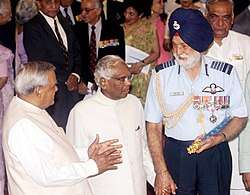
After a three year stint at Bern, Singh then took over as the High Commissioner of India to Kenya in 1974.[31] Singh spent three years heading the High Commission of India at Nairobi, till 1977. Subsequently, he served as a member of the National Commission for Minorities from 1978 to 1981.[29]
Singh also served as the Chairman of the Indian Institute of Technology Delhi from 1980 to 1983 and was a Director of the Grindlays Bank from 1981 to 1988.[32]
On 12 December 1989, Singh was appointed Lieutenant Governor of Delhi by the President of India.[33] He served in the position for a year, till December 1990.[34]
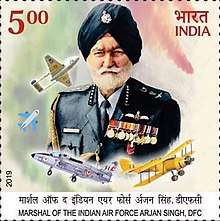
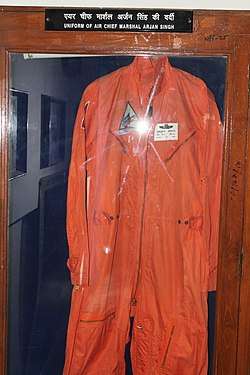
Promotion to Marshal of the Indian Air Force
On 25 January 2002, the Government of India announced that the rank of Marshal of the Indian Air Force was to be conferred on Air Chief Marshal Arjan Singh, DFC, with effect from 26 January 2002, in recognition of the most valuable services to the Air Force and the Nation. The rank is the highest in the Indian Air Force. It is equivalent to Field Marshal and is held for life.[35] The President of India, K. R. Narayanan conferred the Five-star rank on Marshal of the Indian Air Force Arjan Singh and handed the Marshal's baton in a ceremony at the Rashtrapati Bhavan on 23 April 2002.[36]
Personal life
In 1948, Singh married Teji Singh, a lady of his own community and similar family background, in a match arranged by their families. They were married for 63 years before her death in April 2011. In 1949, their first daughter Amrita was born. Three years later, her brother Arvind Singh was born and the Singhs' youngest child Asha followed another three years later.[37] Teji Singh was the maternal aunt of actress Mandira Bedi.[38]
Later years and Death
Singh's health declined in his final years, and he frequently made references to growing old and the passing away of many of his friends.[37] In July 2015, then aged 96 and using a wheelchair due to a temporary indisposition, he was among the many dignitaries to lay a wreath at the base of the coffin carrying the mortal remains of former President A.P.J. Abdul Kalam at Palam Airport. He paid his last respects to President Kalam at Palam Airport on 28 July.[39] He remained active even at 98, continuing to take tea and to play golf twice a week at the Delhi Golf Club.[38][37]
Singh suffered a cardiac arrest at his New Delhi residence in the early morning of 16 September 2017 and was rushed to the Army Hospital, Research and Referral, in New Delhi, where his condition was stated to be critical.[40] He died at 7:47 p.m. (IST) that evening.[23] After his passing, his body was returned to his home at 7A Kautilya Marg in New Delhi, where numerous visitors and dignitaries offered their respects, including President Ram Nath Kovind, Prime Minister Narendra Modi, Defence Minister Nirmala Seetaraman and the three service chiefs of the Indian Armed Forces.[41] Accorded a state funeral by the Indian government, he was cremated at Brar Square in New Delhi on 18 September with full military honours, including a military flypast by IAF fighter jets and helicopters.[42] The National Flag flew at half-mast in Delhi.[43]
Legacy
Singh was the first officer to have kept his flying rank until he became CAS. He had flown over 60 different types of aircraft from Pre-WWII era biplanes to Folland Gnats and de Havilland Vampires. He also had flown in transports like the Lockheed L-1049 Super Constellation.[44] Singh remained active and worked for the welfare of air force veterans, contributing twenty million rupees from his personal wealth to set up a trust to this end. He was considered a father figure of the service.[45]
The Air Force Sports Control Board organises an annual Marshal Arjan Singh Memorial All India Hockey Tournament.[46][47][48] The IAF celebrated the birth centenary of the Marshal in April 2019. Events over a period of one year were planned across the country. The celebrations started with a seminar at Air Headquarters titled "Air Power in the 2040s: Impact of Technology", as a tribute to his vision of the Air Force. The then Chief of the Air Staff Air Chief Marshal Birender Singh Dhanoa also unveiled a bust of the Marshal at Air Headquarters.[49]
Air Force Station Arjan Singh
On 14 April 2016, at an event to mark the Marshal's 97th birthday, the then Chief of Air Staff Air Chief Marshal Arup Raha announced that the Indian Air Force base at Panagarh in West Bengal was being renamed to Air Force Station Arjan Singh in honor of the Marshal's service. The airbase was constructed in 1944 by the United States Air Force in the China Burma India Theater during World War II, the same theatre that Singh served in during the war.[50][51][52]
Awards and decorations
Dates of rank

.svg.png)
| Insignia | Rank | Component | Date of rank |
|---|---|---|---|
| Pilot Officer | Royal Indian Air Force | 23 December 1939[54] | |
| Flying Officer | Royal Indian Air Force | 23 June 1941 | |
| Flight Lieutenant | Royal Indian Air Force | 15 May 1942 | |
| Squadron Leader | Royal Indian Air Force | 1 April 1944 (acting)[55] 18 May 1945 (substantive)[56] | |
| Wing Commander | Royal Indian Air Force | February 1945 (acting)[56] 15 August 1948 (substantive)[56] | |
| Group Captain | Royal Indian Air Force | 16 August 1947 (acting)[56] | |
| Group Captain | Indian Air Force | 26 January 1950 (recommissioning and change in insignia)[57] 15 August 1952 (substantive) | |
| Air Commodore | Indian Air Force | 12 December 1950 (acting)[17] 1 October 1955 (substantive)[56] | |
| Air Vice Marshal | Indian Air Force | 1 May 1958 (acting)[58] 16 June 1960 (substantive)[56] | |
| Air Marshal (CAS) | Indian Air Force | 1 August 1964 (acting)[59] 1 December 1964 (substantive)[56] | |
| Air Chief Marshal (CAS) | Indian Air Force | 15 January 1966 [60] | |
| Marshal of the Indian Air Force | Indian Air Force | 26 January 2002[61] | |
See also
- Field Marshal K M Cariappa
- Field Marshal Sam Manekshaw
Notes
- Indian military officers of five-star rank hold their rank for life, and are considered to be serving officers until their deaths.
- Indian military officers of five-star rank hold their rank for life, and are considered to be serving officers until their deaths.
Citations
- "IAF pays tribute to Marshal of Indian Air Force Arjan Singh on 101st birth anniversary". DNA India. 15 April 2020.
- "When Arjan Singh sold off his farm for IAF personnel". The Tribune. 17 September 2017. Archived from the original on 17 September 2017. Retrieved 7 December 2018.
- "Timeline of the life of IAF Marshal Arjan Singh". The Indian Express. 16 September 2017. Archived from the original on 16 September 2017. Retrieved 16 September 2017.
- "Air Marshal Arjan Singh dies at 98". The Statesmen. 16 September 2017. Archived from the original on 16 September 2017. Retrieved 16 September 2017.
- DelhiSeptember 18, Prabhash K. Dutta New; September 18, Prabhash K. Dutta New; Ist, Prabhash K. Dutta New. "Air Force Marshal Arjan Singh was actor Mandira Bedi's uncle and a fourth generation soldier". India Today.
- "New Chief of Air Staff" (PDF). pibarchive.nic.in. 13 May 1964.
- Force, Indian Air (12 April 2019). "#ArjanSingh100 – MIAF Arjan Singh has been a sports achiever. As an ace swimmer, he held an all-India record in freestyle swimming in one mile and half mile events. He was the vice-captain of swimming, athletics and hockey teams during his training at RAF College Cranwell.pic.twitter.com/wUIX1WkJH9". @IAF_MCC.
- Sapru 2014.
- "Arjan Singh The man who was our Marshal". tribuneindia.com.
- "A GLORIOUS ERA COMES TO AN END: THE MARSHAL OF THE INDIAN AIR FORCE ARJAN SINGH A LEGEND BREATHES HIS LAST AT ARMY HOSPITAL (R&R), NEW DELHI". pib.gov.in.
- "Arjan Singh, Indian Air Force Marshall and War Hero, Dies at 98". Loksatta. 16 September 2017. Archived from the original on 6 October 2017. Retrieved 16 September 2017.
- Service, Tribune News. "Arjan Singh The man who was our Marshal". Tribuneindia News Service.
- "No. 36542". The London Gazette (Supplement). 30 May 1944. p. 2534.
- "Arjan Singh: an epitome of military leadership". Manorma Online. Archived from the original on 16 September 2017. Retrieved 16 September 2017.
- "Both of us were part of first flypast over Red Fort on August 15, 1947: Air Marshal Randhir Singh reminisces about Arjan Singh". The Indian Express. 17 September 2017. Archived from the original on 16 September 2017. Retrieved 17 September 2017.
- "Two Air Commodores Become Air Vice-Marshals" (PDF). pibarchive.nic.in. 23 May 1958.
- "WESTERN AIR COMMAND | Indian Air Force | Government of India". indianairforce.nic.in.
- "IAF Station New Delhi celebrates its 6th anniversary" (PDF). pibarchive.nic.in. 15 September 1953.
- "Two Air Commodores Become Air Vice-Marshals" (PDF). pibarchive.nic.in. 23 May 1958.
- "MILESTONES | Indian Air Force | Government of India". indianairforce.nic.in.
- "New Air Chief" (PDF). pibarchive.nic.in. 13 May 1964.
- "New Air Chief calls on prime Minister" (PDF). pibarchive.nic.in. 31 July 1964.
- "Arjan Singh, Marshal of Indian Air Force, passes away". The Times of India. 16 September 2017. Archived from the original on 17 September 2017. Retrieved 16 September 2017.
- Subramaniam 2016, p. 332.
- "GALLANTRY AWARDS TO DEFENCE PERSONNEL" (PDF). pibarchive.nic.in. 22 November 1965.
- "Arjan Singh, Marshal of Indian Air Force, Dies at 98". NDTV. 16 September 2017. Archived from the original on 16 September 2017. Retrieved 16 September 2017.
- "HIGHER RANK FOR AIR CHIEF" (PDF). pibarchive.nic.in. 20 January 1966.
- "AIR CHIEF MARSHAL ARJAN SINGH TO TAKE SALUTE AT THE ROYAL AIR FORCE COLLEGE, CRANWELL" (PDF). pibarchive.nic.in. 15 May 1967.
- "Arjan Singh, Marshal of the Indian Air Force and key figure in 1965 Pak war, dies at 98". Hindustan Times. 16 September 2017. Archived from the original on 16 September 2017. Retrieved 16 September 2017.
- "Air Chief Marshal Arjan Singh presented his credential" (PDF). pibarchive.nic.in. 3 April 1971.
- "Arjan Singh Envoy to Kenya" (PDF). pibarchive.nic.in. 14 March 1974.
- "PIB". pibarchive.nic.in. 25 January 2002.
- "PRESS COMMUNIQUE" (PDF). pibarchive.nic.in. 12 December 1989.
- "Press Communique" (PDF). pibarchive.nic.in. 14 December 1990.
- "INDIA'S FIRST MARSHAL OF THE AIR FORCE". pibarchive.nic.in. 25 January 2002.
- "World War II, 1965 India-Pakistan War: A look at Arjan Singh's distinguished career". Hindustan Times. 16 September 2017.
- Singh 2002.
- "Mandira Bedi remembers uncle Arjan Singh: Even at 98, he used to play golf twice a week". The Hindustan Times. 17 September 2017. Archived from the original on 17 September 2017. Retrieved 17 September 2017.
- "The last journey of former President Dr APJ Abdul Kalam - Dr Abdul Kalam's funeral". The Economic Times.
- "Arjan Singh, Marshal of the Indian Air Force, critically ill, PM Modi visits him at Army R&R hospital". The Indian Express. 16 September 2017. Archived from the original on 16 September 2017. Retrieved 16 September 2017.
- "State funeral for Arjan Singh; flag to fly at half mast in Delhi". The Hindu. 17 September 2017. Archived from the original on 8 October 2017. Retrieved 17 September 2017.
- "Marshal Arjan Singh cremated with military honours". The Hindu. 18 September 2017. Archived from the original on 3 October 2017. Retrieved 19 September 2017.
- "National Flag will fly half-mast tomorrow in Delhi". pib.gov.in.
- "Arjan Singh Padma Vibhushan, DFC CAS | Indian Air Force | Government of India". indianairforce.nic.in.
- "Marshal of The Air Force | Indian Air Force | Government of India". indianairforce.nic.in.
- "Marshal Arjan Singh Memorial All India Hockey Tournament". pib.gov.in.
- "Marshal Arjan Singh memorial All India Hockey Tournament held at Chandigarh from May 7–12". uniindia.com.
- "2nd Marshal Arjan Singh Memorial International Hockey Tournament 2019 Kicks off at Chandigarh". pib.gov.in.
- "IAF Celebrates Birth Centenary of Late Marshal of the Indian Air Force Arjan Singh DFC". pib.gov.in.
- Sen, Sudhi Ranjan (15 April 2016). "India's Oldest Serving Soldier, Marshal of Air Force, Gets Rare Honour". NDTV. Archived from the original on 15 April 2016. Retrieved 15 April 2016.
To honour India's oldest serving soldier, Marshal of the Air Force Arjan Singh – who turned 97 on Thursday...
- "Bengal air base named after Arjan Singh". The Tribune. 15 April 2016. Archived from the original on 18 April 2016. Retrieved 15 April 2016.
- "Panagarh airbase to be renamed after Air Chief Marshal Arjan Singh". ANI News. Archived from the original on 17 April 2016. Retrieved 14 April 2016.
- Pandey, Saurabh (15 April 2017). "Meet Marshal Arjan Singh, Who Made IAF A Nightmare for the Enemies And Guardian of Our Skies". Storypick. Archived from the original on 16 September 2017. Retrieved 16 September 2017.
- The Air Force List: October 1940. HM Stationery Office. 1940. p. 702.
- "Service Record for Marshal of the Air Force Arjan Singh 1577 GD(P) at Bharat Rakshak.com". Bharat Rakshak.
- "Marshal of the Air Force Arjan Singh". Bharat Rakshak. Retrieved 6 March 2018.
- "New Designs of Crests and Badges in the Services" (PDF). Press Information Bureau of India – Archive.
- "Senior Air promotions in IAF" (PDF). pibarchive.nic.in. 23 May 1958.
- "New Air Chief calls on prime Minister" (PDF). pibarchive.nic.in. 31 July 1964.
- "Only Marshal of IAF, hero of 1965, Arjan Singh shaped the force". The Indian Express. 17 September 2017. Archived from the original on 17 September 2017. Retrieved 17 September 2017.
- "Latest Releases". pibarchive.nic.in. 25 January 2002.
- "President Pranab Mukherjee honours Arjan Singh, others on golden jubilee of 1965 war triumph". India.com. 22 September 2015. Archived from the original on 16 September 2017. Retrieved 16 September 2017.
References
- Sapru, Somnath (2014), Combat Lore: Indian Air Force 1930-1945, KW Publishers Pvt Ltd, ISBN 978-9383649259
- Singh, Roopinder (2002), Arjan Singh: Marshal of the Indian Air Force, Rupa, ISBN 978-8171679386
- Subramaniam, Arjun (2016), India's Wars: A Military History, 1947-1971, HarperCollins, ISBN 978-9351777496
External links
| Wikimedia Commons has media related to Arjan Singh. |
- Marshal of the Air Force Arjan Singh – Indian Air Force Official Website
- Marshal of the Air Force Arjan Singh
- Book on Arjan Singh: Marshal of The Indian Air Force (Hardcover)
- Book review on Arjan Singh: Marshal of The Indian Air Force
- Article on Marshal of The Indian Air Force Arjan Singh
| Military offices | ||
|---|---|---|
| Preceded by General Jayanto Nath Chaudhuri |
Chairman of the Chiefs of Staff Committee 1966–1969 |
Succeeded by Admiral Adhar Kumar Chatterji |
| Preceded by Aspy Engineer |
Chief of the Air Staff (India) 1964–1969 |
Succeeded by Pratap Chandra Lal |
| Preceded by Aspy Engineer |
Vice Chief of the Air Staff (India) 1963–1964 |
Succeeded by Pratap Chandra Lal |
| Preceded by Atma Ram Nanda |
Air Officer Commanding-in-Chief Operational Command 1955–1959 |
Succeeded by Erlic Pinto |
| Preceded by Aspy Engineer |
Air Officer Commanding Operational Command 1950–1952 |
Succeeded by Atma Ram Nanda |
| Preceded by Surendra Nath Goyal |
Commanding Officer No. 1 Squadron IAF 1943–1944 |
Succeeded by Ramaswamy Rajaram |
| Diplomatic posts | ||
| Preceded by M A Hussain |
Ambassador of India to Switzerland, The Holy See & Liechtenstein 1971–1974 |
Succeeded by Avtar Singh |
| Preceded by K C Nair |
High Commissioner of India to the Republic of Kenya 1974–1977 |
Succeeded by A. N. D. Haksar |
| Political offices | ||
| Preceded by Romesh Bhandari |
Lieutenant Governor of Delhi 1989–1990 |
Succeeded by Markandey Singh |
.svg.png)
